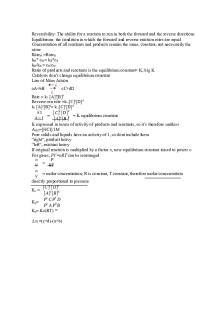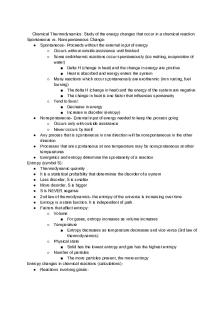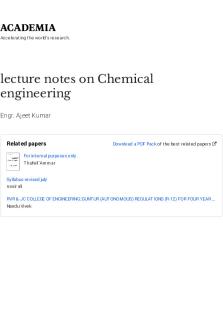Chemical Equilibrium - Lecture notes 6 PDF

| Title | Chemical Equilibrium - Lecture notes 6 |
|---|---|
| Author | Jade Boyd |
| Course | General Chemistry Ii |
| Institution | New Mexico State University |
| Pages | 9 |
| File Size | 290.1 KB |
| File Type | |
| Total Views | 156 |
Summary
Dr. Dunlavy's general chemistry II lecture notes on chemical equilibrium...
Description
Chemical Equilibrium Friday, September 21, 2018
11:52 AM
Characteristics of an Equilibrium System: •
Forward and reverse reactions occurring at the same rate. ○ Dynamic- continually moving/reacting/changing Reaction isn't "over", hasn't "stopped" ○ Constant amounts of everything ○ Some of everything present Mathematically, ratios of amounts give rise to a constant
•
Can be changed by ○ Adding/removing reactants or products ○ Changing temperature or pressure/volume If changed, there is a different amount of everything but still some of everything
H2 (g) + I2 (g)
2HI
H2 I2
HI
C
i
Dynamic Equilibrium
Concentration
Time
Reactant-favored (K1) Reactant Products
Products
Reactants
Equilibrium
Equilibrium
Law of Mass Action (Equilibrium Expressions) [C]c[D]d K= a b [A] [B]
c[D]d [C] Kc= a b [A] [B]
[]
Molarity
Kc
Molarity in gases
Kp
Ratio of pressures in atmospheres
K
Aqueous solutions in molarity
practice
c P d P C D Kp = PAa PBb
NH4+(aq) + OH-(aq)
NH3(aq) + H2O (l)
+][OH-] [NH 4 K= [NH3] N2(g) + 3H2(g)
Kc= [NH3]
2NH3(g)
2
[N2][H2]3
(PNH3)2 Kp = (Pn2)(PH2)3
LHS- Left hand side RHS- right hand side If K1 (104 or so) • a lot more RHS present @ equilibrium than LHS • "product favored equilibrium" • forward reaction does happen to a great extent
• • • •
Solids and liquids never appear in equilibrium expression Gases can appear either as partial pressures (atm) or as concentration (M) Aqueous solutions are expressed as molarity K depends on temperature- If T is changed, K changes
•
In general 𝐾 = &$% Water does not appear in equilibrium expressions aA + bB cC + dD
• •
#
%$ aA + bB
cC + dD
Manipulating Eq. Expressions The value for the equilibrium constant depends on how we write the reaction The value of K depends on how we write our reaction
Changing direction 1. S(s) + O2(g)
SO2(g)
SO2(g)
Kc = [SO2]/[O2] = 4/2 = 2
S(s) + O2(g)
Kc' = [O2]/[SO2] = 2/4 = 1/2
Inverse relationship AKA reciprocal relationship 2. N2(g) + 3H2(g)
2NH3(g)
2NH3(g)
N2(g) + 3H2(g)
K = 3 x 108
K' = 1/3 x 10-8
Changing coefficients 1. S(s) + 3/2 O2(g)
2 S(s) + 3 O2(g)
SO3(g)
2 SO3(g)
To change these coefficients, we multiplied everything by an "x factor" in this case, x = 2
(Kc)x = Kc' Combining balanced chemical equations H2CO3 + H2O
H3O+ + HCO3-
K1 = 4.20 x 10-7 = [H3O+][HCO3-]/[H2CO3]
HCO - + H O
H O+ + CO
K
2-
4 80 x 10-1 [H O+][CO 2-]/ [HCO -]
HCO3 + H2O H3O+ + CO32 K2 = 4.80 x 10 1 = [H3O+][CO32 ]/ [HCO3 ] If we add the two reactions together we get: H2CO3 + HCO3- + 2H2O 2H3O+ + HCO3- + CO32Use this information to determine the equilibrium constant for the reaction: H2CO3 + 2H2O
2H3O+ + CO32-
K=?
K= (K1)(K2) = [H3O+][HCO3-]/[H2CO3] x [H3O+][CO32-]/ [HCO3-] = [H3O+]2[CO32-]/[H2CO3]
Changing direction
Inverse
Changing coefficients (Kc)x = Kc' Combining equations K= (K1)(K2)
Reaction Quotient Tells us if we are at equilibrium or not. Symbol = Q ( 𝑅𝐻𝑆) -𝑎𝑐𝑡𝑢𝑎𝑙-𝑐𝑜𝑛𝑐𝑒𝑛𝑡𝑟𝑎𝑡𝑖𝑜𝑛𝑠 (𝐿𝐻𝑆)-𝑎𝑐𝑡𝑢𝑎𝑙-𝑐𝑜𝑛𝑐𝑒𝑛𝑡𝑟𝑎𝑡𝑖𝑜𝑛𝑠 ( 𝑅𝐻𝑆) -𝑒𝑞𝑢𝑖𝑙𝑖𝑏𝑟𝑖𝑢𝑚-𝑐𝑜𝑛𝑐𝑒𝑛𝑡𝑟𝑎𝑡𝑖𝑜𝑛𝑠 𝐾= (𝐿𝐻𝑆)-𝑒𝑞𝑢𝑖𝑙𝑖𝑏𝑟𝑖𝑢𝑚-𝑐𝑜𝑛𝑐𝑒𝑛𝑡𝑟𝑎𝑡𝑖𝑜𝑛𝑠 𝑄=
If… Q=K
we are at equilibrium
QK
Too much RHS present Numerator is too big The reverse reaction needs to happen to reduce the RHS (increase LHS) so that Q = K
Equilibrium lies to left practice Butane
Isobutane
K = 2.5 If [Iso] = 0.35 M and [n] = 0.15 M, are you at equilibrium? Q = .35/.15 = 2.3333 Q...
Similar Free PDFs

Chemical equilibrium 1 report
- 9 Pages

Chemical Equilibrium I
- 9 Pages

Worksheet - Chemical Equilibrium
- 8 Pages

Equilibrium notes
- 6 Pages

Chemical Kinetics - Lecture notes 1
- 23 Pages
Popular Institutions
- Tinajero National High School - Annex
- Politeknik Caltex Riau
- Yokohama City University
- SGT University
- University of Al-Qadisiyah
- Divine Word College of Vigan
- Techniek College Rotterdam
- Universidade de Santiago
- Universiti Teknologi MARA Cawangan Johor Kampus Pasir Gudang
- Poltekkes Kemenkes Yogyakarta
- Baguio City National High School
- Colegio san marcos
- preparatoria uno
- Centro de Bachillerato Tecnológico Industrial y de Servicios No. 107
- Dalian Maritime University
- Quang Trung Secondary School
- Colegio Tecnológico en Informática
- Corporación Regional de Educación Superior
- Grupo CEDVA
- Dar Al Uloom University
- Centro de Estudios Preuniversitarios de la Universidad Nacional de Ingeniería
- 上智大学
- Aakash International School, Nuna Majara
- San Felipe Neri Catholic School
- Kang Chiao International School - New Taipei City
- Misamis Occidental National High School
- Institución Educativa Escuela Normal Juan Ladrilleros
- Kolehiyo ng Pantukan
- Batanes State College
- Instituto Continental
- Sekolah Menengah Kejuruan Kesehatan Kaltara (Tarakan)
- Colegio de La Inmaculada Concepcion - Cebu










